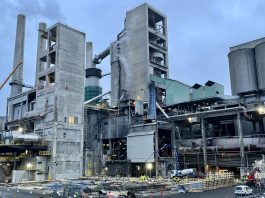A revolutionary US project has received $540,000 in funding to innovate a method that captures industrial emissions and sequesters them via 3D-printing concrete.
Provided by the US Department of Energy, the sizeable grant will enable Oregon State University and Sandia National Laboratory researchers to explore 3D-printing concrete as an effective carbon capture method.
The project aims to capture carbon dioxide from industrial emissions and sequester it in a mineralised form in 3D-printed building materials, therefore taking a sector that is a significant emitter of carbon emissions – the construction industry – and making it greener.
Pavan Akula, assistant professor of civil engineering at the OSU College of Engineering, explained: “In recent years, 3D-printing concrete has been gaining popularity in building construction as it is a more sustainable alternative – it reduces both waste and transport costs. However, most 3D-printing of concrete still relies only on traditional materials that are really carbon intensive.”
Construction industry emissions are at record levels
Research from the International Energy Agency (IEA) has outlined the dire landscape of industrial emissions. The IEA found that in 2021 alone, industrial activity accounted for 9.4 Gt of CO2 – around 25% of global emissions.
Moreover, the building and construction industry’s energy consumption and CO2 emissions are at an all-time high, despite investments in energy efficiency and lower energy density methods.
The 2022 Global Status Report for Buildings and Construction revealed that the industry was responsible for over 34% of energy demand and 37% of energy and process-related CO2 emissions in 2021.
Inger Andersen, Executive Director of the United Nations Environment Programme (UNEP), commented: “The buildings sector represents 40% of Europe’s energy demand, 80% of it from fossil fuels.
“This makes the sector an area for immediate action, investment, and policies to promote short and long-term energy security.”
Akula explained that it will be crucial to decarbonise the construction sector to meet 2050 climate targets.
He said: “Shrinking the carbon footprint of cement-based construction materials is imperative if we’re to hit decarbonisation and climate targets set by the Paris Agreement.”
3D-printing concrete can accelerate industry decarbonisation
What causes substantial carbon emissions in the construction industry? The most commonly used cement globally – known as Portland cement – was pioneered in England in the early 1800s and is the main binder used in concrete.
Portland cement is developed by mining, grinding, and heating clay and limestone in industrial kilns to soaring temperatures – up to 2,820°F. This process changes the chemistry of the material and creates the main component of cement – called clinker – which generates carbon dioxide.
The team is confident that 3D-printing concrete can effectively mitigate the sector’s rising carbon emissions.
Akula concluded: “We plan to capture CO2 emitted from the lime and cement industries and develop sustainable binders capable of storing and mineralising the captured CO2 in printed building components such as walls.
“Our project aims to develop technologies and materials that can significantly reduce the carbon footprint of materials used in 3D printing.”





